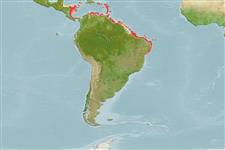Common names from other countries
Environment: milieu / climate zone / depth range / distribution range
Écologie
; profondeur 0 - 8 m (Ref. 83435). Tropical; 18°N - 13°S, 76°E - 32°E (Ref. 83435)
Western Atlantic: Greater Antilles and Caribbean to Brazil.
Length at first maturity / Taille / Poids / Âge
Maturity: Lm ? range ? - ? cm Max length : 5.0 cm DL mâle / non sexé; (Ref. 83435); common length : 3.7 cm TL mâle / non sexé; (Ref. 355)
Description synthétique
Morphologie
Shell of medium size, elliptical. Sculpture or irregular, radial grooves and narrow, flat ribs, all crossed by fine lines. Margin irregular. Orifice oblong, large with sides bearing small upward projections. Colour: greyish to pinkish white, usually with purple blotches and lines between ribs. Internally with green and whitish concentric bands. Border of orifice internally deep green.
On hard substrates; species belongs to a family with a habitat located in the intertidal or shallow subtidal hard substrates (Ref. 355).
Life cycle and mating behavior
Maturité | Reproduction | Frai | Œufs | Fécondité | Larves
Members of the order Patellogastropoda are mostly gonochoric and broadcast spawners. Life cycle: Embryos develop into planktonic trocophore larvae and later into juvenile veligers before becoming fully grown adults.
Leal, J.H. 2003. (Ref. 355)
Statut dans la liste rouge de l'IUCN (Ref. 130435)
statut CITES (Ref. 108899)
Not Evaluated
Not Evaluated
Utilisations par l'homme
Pêcheries: commercial
| FishSource |
Outils
Plus d'informations
Taille/ÂgeCroissanceLongueur-poidsLongueur-longueurMorphologieLarvesAbondance
Sources Internet
Estimates based on models
Preferred temperature
(Ref.
115969): 27.1 - 28.4, mean 27.6 (based on 255 cells).
Catégorie de prix
Unknown.
